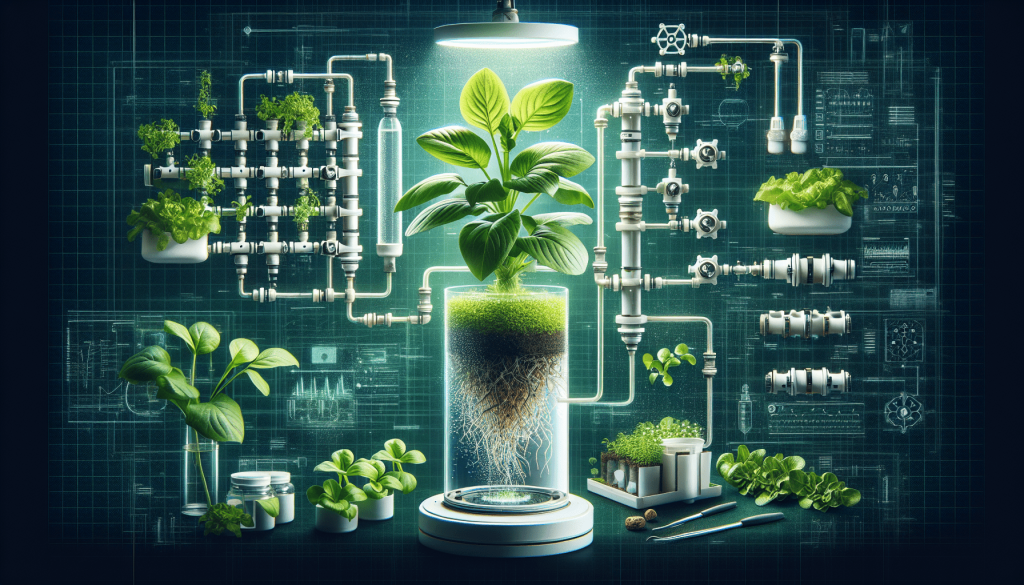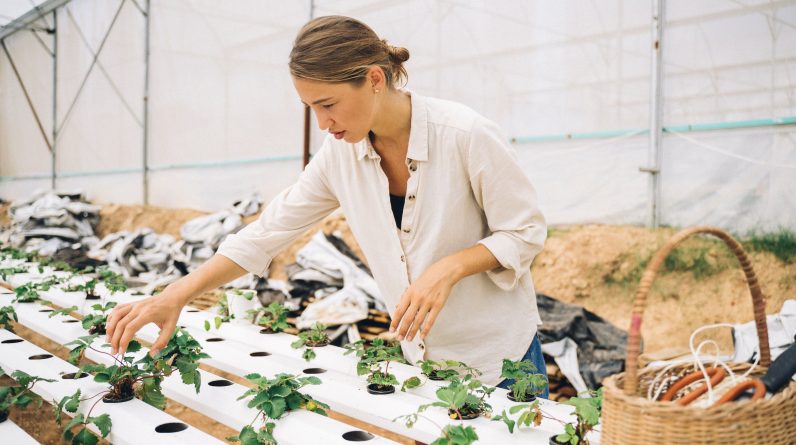
Imagine a world where you can grow fresh, healthy, and pesticide-free fruits and vegetables in the comfort of your own home, all year round. Say goodbye to the limitations of traditional soil-based gardening and say hello to the revolutionary hydroponic growing system. This innovative method of cultivation is making waves in the world of agriculture, allowing individuals to grow a wide variety of plants without the need for soil. By providing plants with the essential nutrients they need directly in water, hydroponics offers a more efficient and sustainable way to cultivate crops. Say hello to the future of gardening with the hydroponic growing system.
What is a hydroponic growing system?
A hydroponic growing system is a method of cultivating plants without the use of soil. Instead, the plants are grown in nutrient-rich water solutions, providing them with all the necessary nutrients for optimal growth. This innovative technique allows for plants to be grown in various settings, whether it be indoors, in greenhouses, or even in vertical farms. By controlling factors such as nutrient levels, pH, and lighting, hydroponic systems provide an efficient and sustainable way of producing fresh and high-quality crops.
Definition
A hydroponic growing system can be defined as a cultivation method in which plants are grown in a soil-less environment and are provided with nutrient-rich water solutions to support their growth and development. This technique eliminates the need for traditional soil-based cultivation and allows for more precise control over the plant’s environment.
Benefits
There are several benefits of using a hydroponic growing system. Firstly, this method conserves water as it requires significantly less water compared to traditional soil-based cultivation. The water used in hydroponics is recirculated, reducing the amount of water wasted. Additionally, hydroponic systems enable faster plant growth and higher crop yields, resulting in increased productivity. This is due to the optimized and controlled conditions provided by hydroponics, allowing plants to receive all the necessary nutrients without competition from weeds or nutrient-deficient soil. Furthermore, hydroponic systems are space-efficient and can be set up in areas with limited space, making them suitable for urban areas or indoor gardening. Lastly, hydroponic systems reduce the reliance on pesticides as the controlled environment minimizes the chances of pest infestations, promoting healthier crops and reducing chemical usage.
Different types of hydroponic growing systems
Nutrient Film Technique (NFT)
One type of hydroponic growing system is the Nutrient Film Technique (NFT), which involves a continuous flow of nutrient-rich water over the plant’s roots. In this system, plants are placed in channels or troughs with a thin film of nutrient solution flowing through them. The roots of the plants are constantly exposed to the nutrient solution as it flows over them, providing them with a constant supply of nutrients. This method is particularly effective for growing smaller plants with shallow root systems, such as lettuce or herbs.
Drip System
The drip system, also known as the drip irrigation system, is another commonly used hydroponic growing system. In this system, plants are grown in containers or pots filled with an inert growing medium, such as perlite or rockwool. A network of tubes and emitters is used to deliver a carefully controlled drip of nutrient solution directly to the plant’s roots. This system allows for precise control over the amount and timing of the nutrient solution delivered, ensuring optimal growth and minimizing water waste.
Deep Water Culture (DWC)
The Deep Water Culture (DWC) system is a hydroponic growing system in which plants are suspended in nutrient-rich water. The roots of the plants are submerged in the water, and an air pump is used to provide oxygen to the roots. This system is simple and cost-effective, as it requires fewer components compared to other hydroponic systems. DWC is particularly suitable for larger plants with deeper root systems, such as tomatoes or cucumbers.
Ebb and Flow (Flood and Drain)
The Ebb and Flow, also known as Flood and Drain, system is a hydroponic growing system that utilizes periodic flooding and draining of the growing tray. Plants are grown in containers filled with a growing medium, and a nutrient solution is periodically pumped into the tray, flooding the roots. After a specific amount of time, the nutrient solution is drained back into a reservoir. This cyclic flooding and draining of the roots ensure that they receive a sufficient oxygen supply, promoting healthy plant growth.
Aeroponics
Aeroponics is a unique hydroponic growing system that suspends plant roots in an air or mist environment. Instead of using a growing medium, plants are cultivated in a chamber where their roots are regularly misted with a nutrient-rich solution. This misting system provides an optimal balance of oxygen, nutrients, and water to the plants. Aeroponics allows for faster growth rates and higher yields, making it an efficient and innovative hydroponic growing system.

Components of a hydroponic growing system
To set up a hydroponic growing system, several essential components are required. These components work together to create an optimal growing environment for plants. Some of the key components include:
Growing Medium
In hydroponics, a growing medium is used to support the plant’s roots. Common growing mediums include rockwool, perlite, coconut coir, and vermiculite. These mediums provide stability to the plants and allow for the proper distribution of water, air, and nutrients.
Nutrient Solution
The nutrient solution is a vital component of a hydroponic system as it provides all the necessary nutrients for plant growth. This solution usually consists of water mixed with a commercially available nutrient solution or a homemade nutrient blend. The nutrient solution is carefully balanced to provide the right amount and ratio of essential nutrients required for optimal plant growth.
Lighting
Since hydroponic systems can be set up indoors or in areas with limited natural sunlight, artificial lighting is necessary for the plants’ photosynthesis process. LED grow lights are commonly used in hydroponics, as they provide the right spectrum and intensity of light for healthy plant growth.
Water Pump
A water pump is used to circulate the nutrient solution throughout the hydroponic system. It ensures that the plants receive a constant supply of fresh nutrient solution, preventing stagnation and creating a healthy growing environment.
Reservoir
The reservoir is where the nutrient solution is stored before being pumped into the system. It should be large enough to hold an ample supply of nutrient solution and should be made of a material that is non-toxic to the plants.
pH Testing Kit
Maintaining the correct pH level is crucial in hydroponics, as it affects the plant’s ability to absorb nutrients. A pH testing kit is used to regularly monitor and adjust the pH level of the nutrient solution to ensure optimal nutrient uptake by the plants.
Air Pump and Air Stones
To provide oxygen to the plants’ roots, an air pump and air stones are used. These components create bubbles in the nutrient solution, enhancing oxygenation and preventing root rot.
Timers and Controllers
Timers and controllers are used to automate various aspects of the hydroponic system, such as controlling the lighting schedule, nutrient solution delivery, and water pump operation. This automation allows for precise control over the growing environment and reduces the need for constant manual monitoring.
Setting up a hydroponic growing system
Setting up a hydroponic growing system requires careful planning and consideration. The following steps outline the process of setting up a hydroponic system:
Selecting a suitable location
The first step is to choose an appropriate location for your hydroponic system. Consider factors such as available space, access to water and electricity, and the amount of natural sunlight or artificial lighting available.
Choosing the right type of system
Select a hydroponic system that suits your needs and resources. Consider factors such as the type of plants you want to grow, available space, and budget constraints. Each system has its own advantages and requirements, so choose one that aligns with your goals and resources.
Prepare the growing area
Clean and prepare the designated growing area before installing the hydroponic system. Remove any debris or obstacles and ensure the area is clean and sanitized to prevent the growth of pathogens or pests.
Installing the necessary equipment
Install the various components of the hydroponic system according to the manufacturer’s instructions. This includes setting up the growing containers, connecting the water pump and air pump, and arranging the lighting system. Ensure that all connections are secure and that the system is properly assembled.
Mixing and adjusting the nutrient solution
Follow the directions provided with your nutrient solution to mix it properly. Test the pH level of the solution using a testing kit and adjust it as needed to ensure it falls within the optimal range for the plants you are growing.
Starting the seeds or transplanting seedlings
Once your hydroponic system is set up and the nutrient solution is prepared, it’s time to start growing your plants. Depending on the type of plants you are growing, either start the seeds in a germination tray or transplant seedlings into the growing containers. Ensure that the roots are properly submerged in the nutrient solution or in contact with the growing medium.
Monitoring and maintaining the system
Regularly monitor the hydroponic system to ensure that all components are functioning properly. Check the nutrient solution levels, pH levels, and water pump operation regularly. Maintain cleanliness in the system to prevent the growth of algae or pathogens. Monitor plant growth and adjust lighting levels or nutrient solution strength as needed. Regularly inspect plants for signs of nutrient deficiencies or pest infestations and take appropriate measures to address these issues.

Maintenance and troubleshooting tips
To ensure the success of your hydroponic growing system, it is important to follow proper maintenance and troubleshooting practices. Here are some tips to keep your system running smoothly:
Regularly check and maintain equipment
Regularly inspect all components of your hydroponic system, including pumps, timers, lighting, and air stones. Clean or replace any clogged air stones and ensure that all pumps are functioning properly. Check for any leaks in the plumbing and repair them promptly. Clean filters or screens to prevent blockages and ensure a continuous flow of water.
Maintaining proper pH and nutrient levels
Monitor the pH level of your nutrient solution regularly and adjust it as needed to ensure that it falls within the optimal range for your plants. Test the nutrient solution for nutrient levels and adjust the strength of the solution if necessary. Follow the guidelines provided by the nutrient solution manufacturer for the best results.
Preventing and treating plant diseases and pests
Hydroponic systems are not immune to plant diseases or pests. Regularly inspect your plants for any signs of diseases, such as wilting, yellowing leaves, or spots. Implement appropriate pest control measures, such as introducing beneficial insects or using organic pest control methods. If necessary, isolate affected plants to prevent the spread of diseases.
Advantages of hydroponic growing systems
Hydroponic growing systems offer numerous advantages over traditional soil-based cultivation methods. Some of the key advantages include:
Water efficiency
Hydroponic systems are highly water-efficient, as they use up to 90% less water compared to traditional soil-based farming methods. The water used in hydroponics is recirculated, preventing water wastage and conserving this precious resource.
Faster growth and higher yields
Plants grown in hydroponic systems have access to an optimized and consistent supply of nutrients, water, and oxygen. This leads to faster growth rates and higher crop yields compared to traditional methods. Hydroponic systems also eliminate competition from weeds, resulting in healthier plants and increased productivity.
Suitable for limited space
Hydroponic systems are ideal for areas with limited space, such as urban environments or small gardens. These systems can be set up vertically, allowing for the cultivation of a large number of plants in a compact area. This makes hydroponics a viable option for urban farming and indoor gardening.
Reduced reliance on pesticides
The controlled environment of hydroponic systems minimizes the chances of pest infestations. The absence of soil eliminates many soil-borne pests, and the controlled nutrient solution prevents the need for chemical pesticides. This results in healthier and safer produce, reducing the reliance on harmful pesticides.
Year-round cultivation
With hydroponics, plants can be grown year-round regardless of the climate or season. Indoor hydroponic systems provide the ideal conditions for plant growth, allowing for continuous cultivation and the availability of fresh produce throughout the year.
Less soil erosion
Traditional agriculture methods often contribute to soil erosion, but hydroponics eliminates the need for soil altogether. This reduces the risk of soil erosion and helps to protect valuable topsoil, which is essential for sustaining agricultural productivity.

Challenges and limitations of hydroponic growing systems
While hydroponic growing systems offer many advantages, there are also some challenges and limitations to consider before implementing this cultivation method:
Initial setup costs
Setting up a hydroponic system can require a significant upfront investment. The cost of purchasing the necessary equipment, such as grow lights, pumps, and controllers, can be higher compared to traditional farming methods. However, it is important to consider the long-term benefits and potential returns on investment.
Technical knowledge required
Hydroponic systems require a certain level of technical knowledge and understanding of plant nutrition and environmental control. Proper monitoring of nutrient levels, pH levels, and overall system maintenance is necessary to ensure successful plant growth. Familiarity with hydroponic principles and practices is essential for achieving optimal results.
Reliant on electricity
Hydroponic systems require a constant supply of electricity to power pumps, lighting systems, and timers. This reliance on electricity makes these systems vulnerable to power outages or fluctuations. It is important to have backup power sources or contingency plans in place to prevent disruptions in plant growth.
Risk of system failures or power outages
Any system is susceptible to failures or malfunctions, and hydroponic systems are no exception. Equipment failures or power outages can have a significant impact on plant growth and crop yields. Regular maintenance and monitoring of the system can help minimize the risk of failures, but it is important to have contingency plans in place in case of emergencies.
Some plants may not thrive in hydroponic systems
While hydroponics is suitable for a wide range of plants, certain varieties may not thrive in this cultivation method. Some plants, such as root crops or large fruiting plants, may have specific requirements that are challenging to meet in a hydroponic system. It is important to research and select plant varieties that are well-suited for hydroponic cultivation.
Applications of hydroponic growing systems
Hydroponic growing systems have various applications in different sectors. Some of the common applications include:
Commercial agriculture
Hydroponic systems are increasingly being used in commercial agriculture for the cultivation of high-value crops, such as lettuce, herbs, microgreens, and specialty vegetables. The controlled environment and increased productivity of hydroponics make it an attractive option for commercial growers.
Indoor home gardening
Hydroponics allows individuals to grow their own fresh produce indoors, regardless of space limitations or climatic conditions. Indoor hydroponic systems provide a convenient and sustainable way to have a year-round supply of fresh herbs, vegetables, and fruits.
Vertical farming
Vertical farming refers to the practice of cultivating plants vertically in stacked layers. Hydroponics is well-suited for vertical farming, as it allows for efficient use of space and increased crop yields. This method is particularly beneficial in urban areas, where land availability is limited.
Educational purposes
Hydroponics is often used in educational settings to teach students about plant biology, nutrition, and sustainable farming practices. Schools and universities may have hydroponic systems as part of their curriculum, providing hands-on learning experiences for students.

Impacts on the environment
Hydroponic growing systems have several positive impacts on the environment. Some of these impacts include:
Reduced water usage
As mentioned earlier, hydroponic systems are highly water-efficient. By recirculating and reusing the nutrient solution, these systems minimize water wastage and reduce the strain on water resources. This is particularly important in water-scarce regions or areas facing drought conditions.
Lower carbon emissions
Hydroponics can help reduce carbon emissions associated with traditional agriculture methods. Since hydroponic systems can be set up in urban areas, the need for long-distance transportation of produce is minimized. This reduces the carbon footprint associated with transportation and contributes to lower greenhouse gas emissions.
Minimal use of chemical fertilizers
Hydroponics relies on nutrient-rich water solutions to provide plants with essential nutrients, reducing the need for chemical fertilizers. This minimizes nutrient leaching into the environment and helps prevent negative impacts on water bodies and ecosystems. Hydroponics promotes sustainable farming practices by minimizing the use of harmful chemicals.
Conclusion
Hydroponic growing systems offer a sustainable and efficient method of cultivation that has numerous advantages. By eliminating the need for soil and optimizing the growing conditions, hydroponics provides a controlled environment that promotes faster growth, higher yields, and water efficiency. These systems can be set up in various locations, making them suitable for commercial agriculture, indoor home gardening, vertical farming, and educational purposes. While there are initial setup costs and technical knowledge required, the benefits of hydroponic systems, such as reduced reliance on pesticides, year-round cultivation, and reduced environmental impacts, make them an appealing option for modern agriculture. With proper setup and maintenance, hydroponic systems can provide fresh and high-quality produce regardless of the available space or climate conditions.








